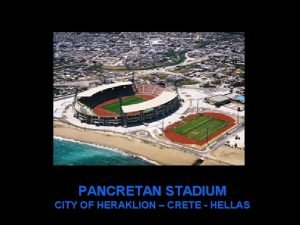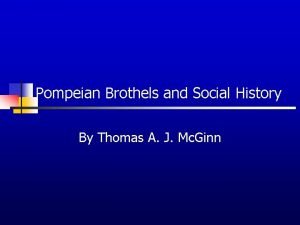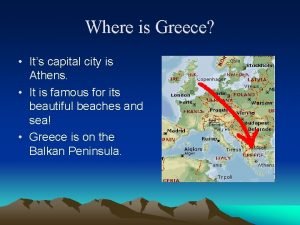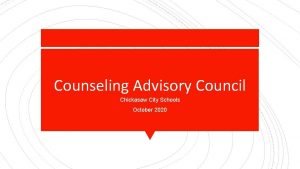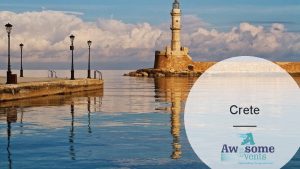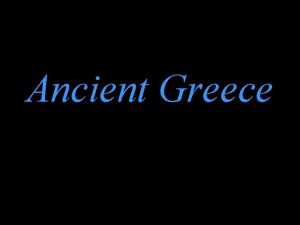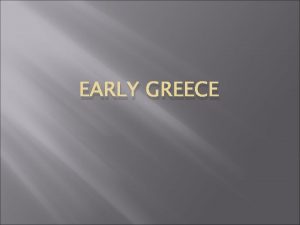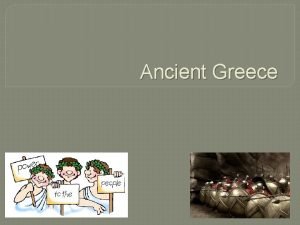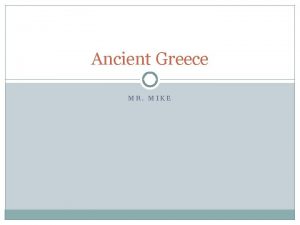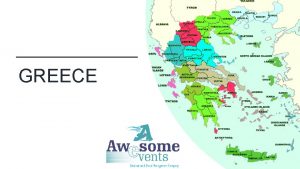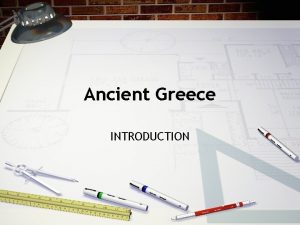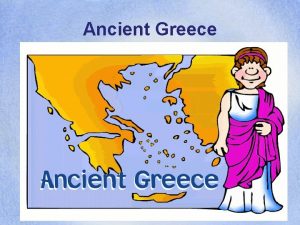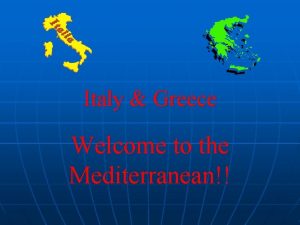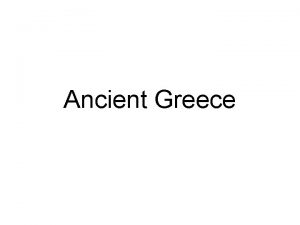GREECE CRETE HERAKLION CITY OUR TOWN OUR SCHOOLS


















- Slides: 18

GREECE

CRETE

HERAKLION CITY – OUR TOWN

OUR SCHOOL’S LOCATION

24 Primary School Heraklion Crete

• Our school is located near the center of the town. It is built of carved stone; it has narrow and tall windows and small black and white tiles. The building is very old. Its history is related with the history of our town.

G. Geronimakis our school’s donator. Characteristic Cretan type, tall, impressive, upstanding man. He cared for people who needed help. Before he died he expressed his desire to donate a warship to his country. But the mayor of the town advised him to set up a Public Nursery, which was a necessity for the town. He died in 1921 at Heraklion.

• In the school’s yard there is a “small house”. Pupils always ask: what’s the use of that baby house? They lie down and play the babies. At that place unmarried women and poor families put their children because they were not able to care for them. They rang a bell and left.

• So the first use of the building was a Public Nursery. These years were very difficult for the town : war , poverty , starvation. The foundation begun its works in March of 1927 , when the first infant came and stopped in the August of 1961. It had the capability to shelter 50 children. At the first year it offered hospitability to 20 children.


• The nursery was headed by a pediatrician until 1958, after which an Administrative Director took over. • There were a secretary, a clerk, two nurses, a cleaning lady, a dairy, feeds and nurseries who nursed the children.

• The foundation’s aim was to bring up abandoned children , to provide them medical relief and to make them feel that they have a family , people who care for them. • Inside the clothes of the children the foundation’s staff usually found notes that wrote their names if they were baptized. • If they were not baptized, the foundation baptized the children in the nearby church. • Each child had its own page, written in the institution's register book and reported the day and time it was found , its kilos and its height, its physical condition and any special feature it had. • On the same page were kept the notes left by the parents and the desires they were likely to have or their will to retrieve when they could. • If the child died, they wrote on the day of death, or if they were given permission to take note of the details of the family who was taking it.

• The foundation kept them until they could work or make their own family. Families with the appropriate qualifications could adopt children from the foundation. • Later the society’s needs changed. It was a necessity for the town an organization for the protection of unmarried mothers to care for them during pregnancy , to help them to give birth to their baby and to protect them or give them for adoption. Thus a new organization came into existence the infant’s center “ Mother ” at August 1961.

• In 1962 , we mention the establishment of the 24 th Εlementary School in which pupils from the surrounding area were registered and housed in a nearby building. From the first year 150 students did lesson in an inappropriate building.

• Tackling the housing needs, the foundation was asked to provide pupils with housing. The President of the Committee of the Metropolitan of Crete foundation finally handed over to the chairman of the Elementary School the keys of the Geronimacheio Foundation for the use of only 3 rooms but after years and the parents' suggestions were finally granted by the Archbishop of Crete the entire building at 1970 - 1971.



 Balkan peninsula map ancient greece
Balkan peninsula map ancient greece Pancretan stadium
Pancretan stadium Brothel heraklion
Brothel heraklion Insaei heraklion
Insaei heraklion Huntsville powerschool
Huntsville powerschool Town b is 380 km due south of town a
Town b is 380 km due south of town a Retail location adalah
Retail location adalah Reach safety schools
Reach safety schools In our town there were many
In our town there were many Holocaustnoun
Holocaustnoun Capital city of greece
Capital city of greece The capital and largest city of greece
The capital and largest city of greece Southland dental peehip
Southland dental peehip Chickasaw city schools jobs
Chickasaw city schools jobs Myschoolfees huntsville city schools
Myschoolfees huntsville city schools Huntsville city schools registration
Huntsville city schools registration Bellwood elementary school chesterfield va
Bellwood elementary school chesterfield va Acps minnie howard
Acps minnie howard Woodbury city public schools
Woodbury city public schools

